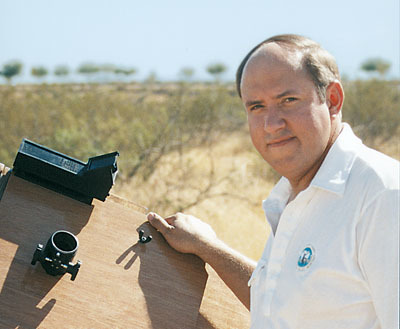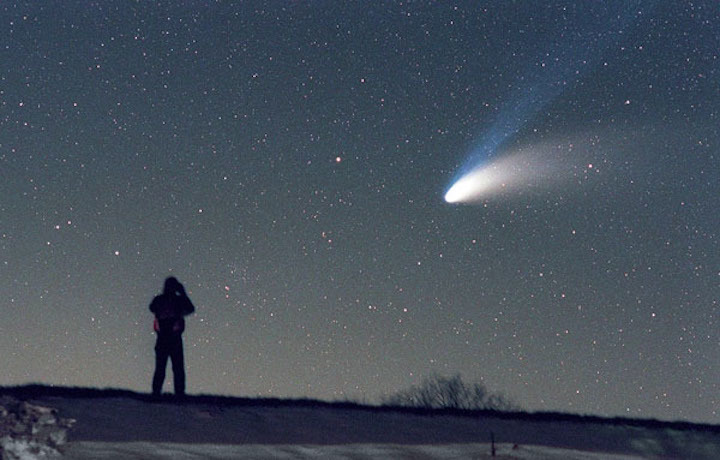13.01.2018
Comet Discoverer Thomas Bopp (1949–2018)
An unassuming amateur astronomer forever linked to one of the greatest comets in modern history has passed away.
Thomas Joel Bopp, the co-discoverer of Comet Hale-Bopp, died January 5, 2018, in Phoenix, Arizona, from liver cancer. He was 68 years old.
As word of his loss was announced on Facebook, colleague Alan Hale wrote, "I was very saddened today to learn of the passing of my friend and 'partner in crime' Thomas J. Bopp," he commented. "Our names are forever linked in history, and if there are any humans left around the year 4393 when H-B should be returning, perhaps they'll think of us, and the times in which we lived. Tom was a warm and congenial fellow, and played a good 'straight man' to my clown act whenever we appeared together."

Thomas Bopp poses with the 17.5-inch reflector he was using when he spied his namesake comet on July 22, 1995.Kevin Gill
-
The two observers — one professional, one casual — became inadvertent partners in one of the greatest comet discoveries in modern times on the night of July 22, 1995. Bopp, who had never seen a comet and didn't even own a telescope, was out stargazing with friends. Alan Hale (a professional astronomer) was at his home in New Mexico. Both men spotted the fuzzy object within 5 minutes of each other.
Neither knew the other had found the object, and both sent messages to Brian Marsden at the IAU's Central Bureau for Astronomical Telegrams in Cambridge, Massachusetts. Hale's emails got there first, but only because Bopp was unable to get through due to spotty cellular service.
"Tom was in the middle of nowhere," Hale recalls. "He had to make the drive home to send a telegram. There was quite a bit of amusement when they received Tom's telegram. Brian Marsden commented that nobody sent telegrams anymore." Eventually, both were credited with the discovery (designated C/1995 O1) and both their names attached to the comet.
Yet they didn't meet in person until later that year, at the Enchanted Skies Star Party in New Mexico. According to organizer David Finley, "They insisted on being booked in separate lodgings so that their first meeting would be in front of the audience at the star party," he said. "Alan spoke first, telling his story of the discovery, then looked out into the audience and said, 'I would like to introduce my friend, Tom Bopp.' Tom then stood up, and the two met and shook hands for the first time in front of the audience."
The comet eventually brightened to magnitude –1 near its perihelion on April 1, 1997 — a stunning evening object seen, according to one survey, by more than two-thirds of all Americans.

Comet Hale-Bopp (C/1995 O1) loomed large in the evening sky the day before its perihelion on March 31, 1997, as 14-year-old Adam Horne eyes it with binoculars.Johnny Horne
-
The experience of being a comet co-discoverer turned into both a blessing and a curse for Bopp. As his fame grew after the comet's discovery, Bopp left his job in response to the heavy schedule of public appearances. The two observers became household names and propelled them into a whirlwind of travel. They were instant media darlings, appearing on TV news shows and in newspaper and magazine interviews. They also gave cruise lectures and university talks. On the flip side, the discovery also brought tragedy, when Bopp's brother and sister-in-law were killed in a car accident after spending a night photographing the comet.
Along with all the accolades, Bopp was was awarded an honorary doctorate from Youngstown State University in Ohio in March, 1998. He was also a member of the "Friends of the Ward Beecher Planetarium" organization at YSU, along with astronaut Ron Parise. Despite being so well known, he remained very down-to-earth, according to Sharon Shanks, retired lecturer at the planetarium. "He was just an ordinary person," she says. "Fun to be with, and somewhat always dumbfounded over his sudden fame."
Bopp was born in Denver, Colorado, on October 15, 1949, and grew up in Youngstown, Ohio. Introduced to the sky by his father, Bopp got his first telescope (a 4-inch reflector) when he was 10 years old. But he didn't get into serious observing — especially deep-sky objects — until retiring from the Air Force in 1972.
Bopp and his family moved to Glendale, Arizona, where he worked as a parts manager. He met Jim Stevens, another local amateur, while picking up some parts at a local supply store. The two became friends and spent weekends observing with Stevens' 17.5-inch Dobsonian reflector. It was on one of those trips — and while looking at M70 through the big Dob — that Bopp chanced upon the comet.
"To understand Tom Bopp, you need to know his father, Frank, as well," explains comet hunter David Levy, who profiled both discoverers in Sky & Telescope's March 1997 issue. "Since the discovery of Comet Hale-Bopp, the father and son have become very close, enjoying the celestial visitor and the night sky as a team."
Bopp continued to pursue his passion for stargazing until his death. He is survived by his daughter, April Bopp-Esch, along with a granddaughter, three sisters, and two brothers.
Quelle: Sky&Telescope
